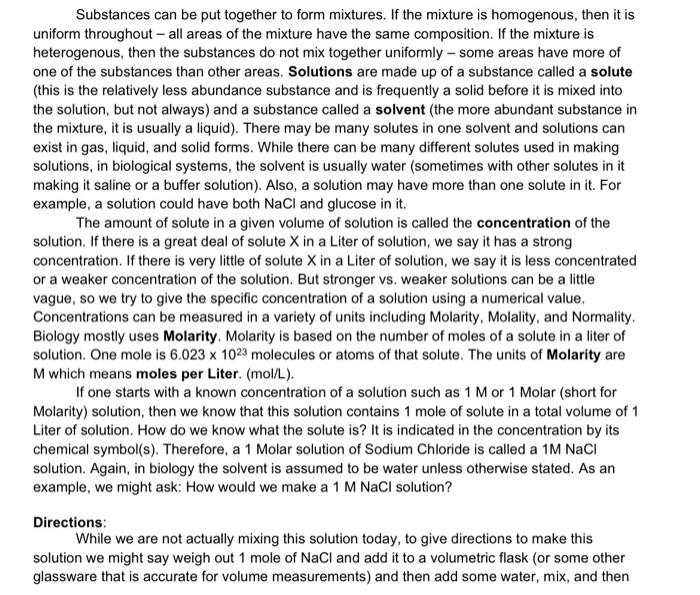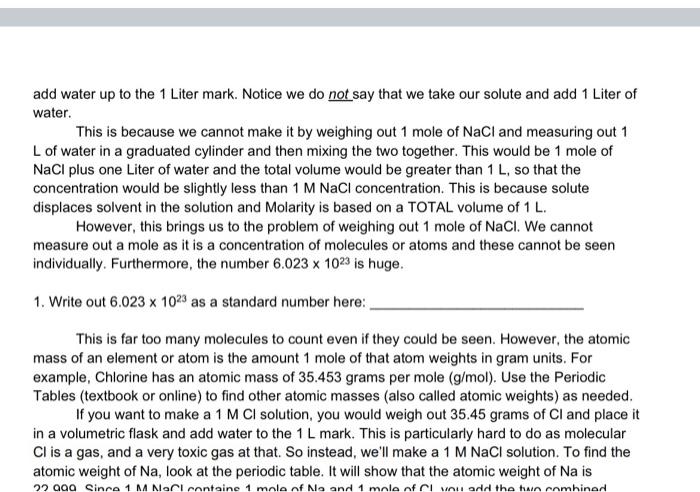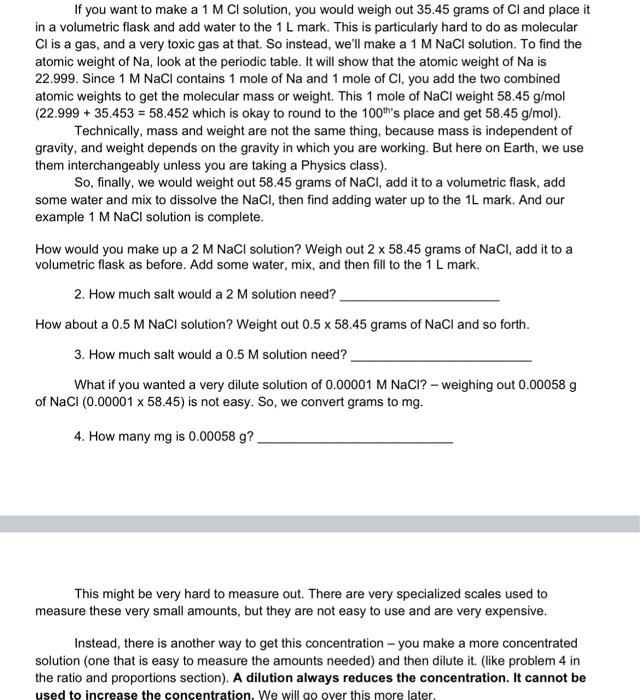Substances can be put together to form mixtures. If the mixture is homogenous, then it is uniform throughout - all areas of the mixture have the same composition. If the mixture is heterogenous, then the substances do not mix together uniformly - some areas have more of one of the substances than other areas. Solutions are made up of a substance called a solute (this is the relatively less abundance substance and is frequently a solid before it is mixed into the solution, but not always) and a substance called a solvent (the more abundant substance in the mixture, it is usually a liquid). There may be many solutes in one solvent and solutions can exist in gas, liquid, and solid forms. While there can be many different solutes used in making solutions, in biological systems, the solvent is usually water (sometimes with other solutes in it making it saline or a buffer solution). Also, a solution may have more than one solute in it. For example, a solution could have both NaCl and glucose in it. The amount of solute in a given volume of solution is called the concentration of the solution. If there is a great deal of solute X in a Liter of solution, we say it has a strong concentration. If there is very little of solute X in a Liter of solution, we say it is less concentrated or a weaker concentration of the solution. But stronger vs. weaker solutions can be a little vague, so we try to give the specific concentration of a solution using a numerical value. Concentrations can be measured in a variety of units including Molarity, Molality, and Normality. Biology mostly uses Molarity. Molarity is based on the number of moles of a solute in a liter of solution. One mole is 6.023 x 1023 molecules or atoms of that solute. The units of Molarity are M which means moles per Liter. (mol/L). If one starts with a known concentration of a solution such as 1 M or 1 Molar (short for Molarity) solution, then we know that this solution contains 1 mole of solute in a total volume of 1 Liter of solution. How do we know what the solute is? It is indicated in the concentration by its chemical symbol(s). Therefore, a 1 Molar solution of Sodium Chloride is called a 1M NaCI solution. Again, in biology the solvent is assumed to be water unless otherwise stated. As an example, we might ask: How would we make a 1 M NaCl solution? Directions: While we are not actually mixing this solution today, to give directions to make this solution we might say weigh out 1 mole of NaCl and add it to a volumetric flask (or some other glassware that is accurate for volume measurements) and then add some water, mix, and then add water up to the 1 Liter mark. Notice we do not say that we take our solute and add 1 Liter of water. This is because we cannot make it by weighing out 1 mole of NaCl and measuring out 1 L of water in a graduated cylinder and then mixing the two together. This would be 1 mole of NaCl plus one Liter of water and the total volume would be greater than 1 L, so that the concentration would be slightly less than 1 M NaCl concentration. This is because solute displaces solvent in the solution and Molarity is based on a TOTAL volume of 1 L. However, this brings us to the problem of weighing out 1 mole of NaCl. We cannot measure out a mole as it is a concentration of molecules or atoms and these cannot be seen individually. Furthermore, the number 6.023 x 1023 is huge. 1. Write out 6.023 x 1023 as a standard number here: This is far too many molecules to count even if they could be seen. However, the atomic mass of an element or atom is the amount 1 mole of that atom weights in gram units. For example, Chlorine has an atomic mass of 35.453 grams per mole (g/mol). Use the Periodic Tables (textbook or online) to find other atomic masses (also called atomic weights) as needed. If you want to make a 1 M Cl solution, you would weigh out 35.45 grams of Cl and place it in a volumetric flask and add water to the 1L mark. This is particularly hard to do as molecular Cl is a gas, and a very toxic gas at that. So instead, we'll make a 1 M NaCl solution. To find the atomic weight of Na, look at the periodic table. It will show that the atomic weight of Na is 22 aga Since 1 M Maclcontaine 1 mola nf Na and 1 mola of CI VALI add the twin combinar If you want to make a 1 M Cl solution, you would weigh out 35.45 grams of Cl and place it in a volumetric flask and add water to the 1L mark. This is particularly hard to do as molecular Cl is a gas, and a very toxic gas at that. So instead, we'll make a 1 M NaCl solution. To find the atomic weight of Na, look at the periodic table. It will show that the atomic weight of Na is 22.999. Since 1 M NaCl contains 1 mole of Na and 1 mole of Cl, you add the two combined atomic weights to get the molecular mass or weight. This 1 mole of NaCl weight 58.45 g/mol (22.999 + 35.453 = 58.452 which is okay to round to the 100th's place and get 58.45 g/mol). Technically, mass and weight are not the same thing, because mass is independent of gravity, and weight depends on the gravity in which you are working. But here on Earth, we use them interchangeably unless you are taking a Physics class). So, finally, we would weight out 58.45 grams of NaCl, add it to a volumetric flask, add some water and mix to dissolve the NaCl, then find adding water up to the 1L mark. And our example 1 M NaCl solution is complete. How would you make up a 2 M NaCl solution? Weigh out 2 x 58.45 grams of NaCl, add it to a volumetric flask as before. Add some water, mix, and then fill to the 1L mark. 2. How much salt would a 2 M solution need? How about a 0.5 M NaCl solution? Weight out 0.5 x 58.45 grams of NaCl and so forth. 3. How much salt would a 0.5 M solution need? What if you wanted a very dilute solution of 0.00001 M NaCl? - weighing out 0.00058 g of NaCl (0.00001 x 58.45) is not easy. So, we convert grams to mg. 4. How many mg is 0.00058 g? This might be very hard to measure out. There are very specialized scales used to measure these very small amounts, but they are not easy to use and are very expensive. Instead, there is another way to get this concentration - you make a more concentrated solution (one that is easy to measure the amounts needed) and then dilute it (like problem 4 in the ratio and proportions section). A dilution always reduces the concentration. It cannot be used to increase the concentration. We will go over this more later









